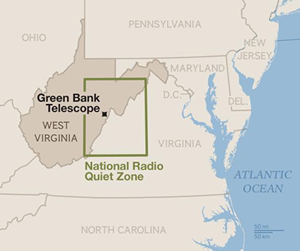Please remember to switch off your mobile phone – forever
In today’s modern world full of IoT devices and super-fast WiFi, visitors to the 13,000 square mile countryside area straddling the borders of West Virginia, Virginia, and Maryland may be shocked by the lack of connectivity. Since the 1950s, when the Federal Communications Commission created the National Radio Quiet Zone, the region has been nearly free of electromagnetic pollution.
Inhabitants only have wired internet access, and smartphones are non-existent.
The Quiet Zone is a mix of mountainous terrain and rustic communities that surround the Green Bank Telescope (GBT), a 485ft. (147.8m) structure that emerges improbably from this remote valley. The GBT is the world's biggest fully steerable radio telescope and one of the largest movable objects anywhere on land.
This mobile-free area was created in order to prevent broadband interference wreaking havoc with the sensitive radio wave detecting equipment. The GBT studies astronomically large objects, such as evaporating comets and distant galaxies, whose signals become astronomically weak by the time they reach Earth. Emissions are measured in janskys, named after the father of radio astronomy, Karl Jansky. A jansky is based on 10-26W - a big signal at Green Bank. If interference gets too strong the telescope's ultrasensitive first amplifier – cooled by liquid helium to minimise internal noise – will shut down.

The interference problem is getting ever larger because, while the electromagnetic spectrum is a finite resource, the number and variety of gadgets emitting electromagnetic energy continues to grow. As the airwaves get busier, the chance of signals ‘overlapping’ is greater. When devices accidentally operate in a neighbouring frequency band, they can run wild: garage doors open and close by themselves, phone conversations blare over baby monitors. The emergency services can also be affected, which could impede the coordination of a disaster response effort.
The lack of interference in The Quiet Zone lets astronomers measure electromagnetic waves thrown off by space-borne molecules when they become heated or collide. Each type of molecule emits energy in a unique frequency band; hydrogen, the most abundant molecule in the universe, is in the 1,400-1,427 MHz range.
All major transmitters in The Quiet Zone are required to coordinate their operations with the national observatory. The FCC doesn't control unlicensed transmitters, but West Virginia's Radio Astronomy Zoning Act prohibits any RFI-generating device – licensed or not – within two miles of the telescope.
The interference-free environment has enabled the GBT to contribute to some impressive discoveries. In September 2014 it was discovered that our Milky Way galaxy is situated in a supercluster of galaxies 500 million light-years in diameter, with a mass of 100 million billion suns. The GBT also recently detected a hydrogen cloud racing toward the Milky Way at 150 miles a second, which is predicted to crash into our galaxy in about 30 million years.
A social media aficionado might imagine that the residents of The Quiet Zone are rather unhappy and out-of-touch, however this is not the case. The region has become a haven for those suffering from electromagnetic hypersensitivity, the belief that exposure to electromagnetic fields results in adverse medical symptoms. Diane Schou suffered from a rash, hair loss and headaches after the installation of a mobile phone mast near her farm in Iowa, and claims that after moving to Green Bank her health has considerably improved.
Michael Holstine, Business Manager of the National Radio Astronomy Observatory, which operates the GBT, agrees: "If you work in Green Bank, it's because you want this kind of life.”
The GBT has $10m annual operating costs, and its future is unclear. For how long can this blackspot remain sustainable?


